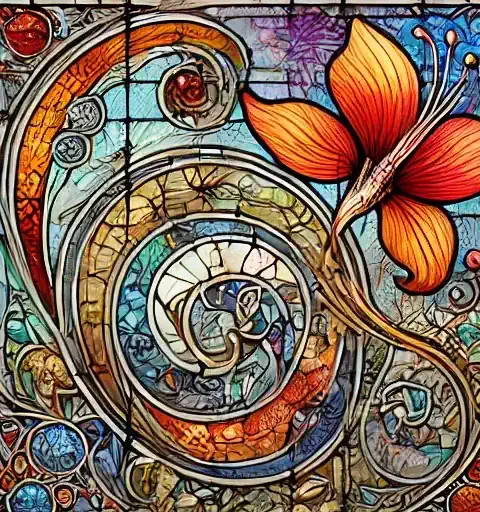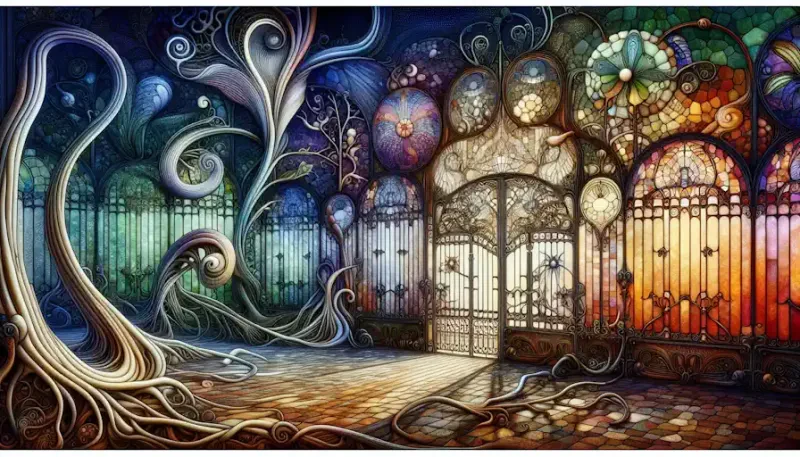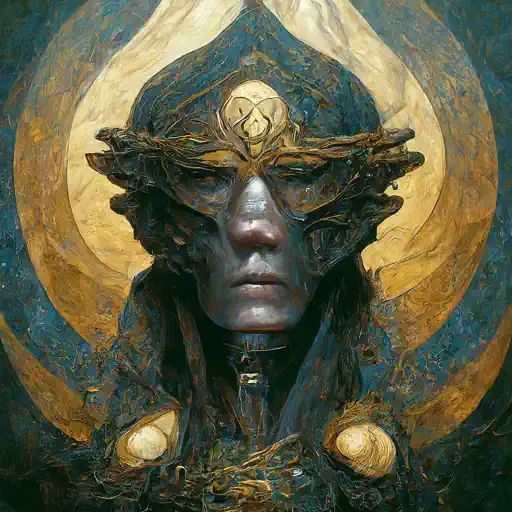Introduction
Art Nouveau, a term derived from French meaning "new art," stands as a testament to the innovative spirit and creative dynamism of the late 19th and early 20th centuries. This introduction aims to provide an immersive journey into the captivating world of Art Nouveau, exploring its origins, defining characteristics, and enduring legacy in the annals of art history.
Definition of Art Nouveau
Art Nouveau, also known as Jugendstil in Germany, Modernismo in Spain, and Stile Liberty in Italy, emerged as a revolutionary artistic movement that sought to break away from the constraints of academic art and embrace a new aesthetic vocabulary characterized by organic forms, sinuous lines, and ornamental intricacy. Rooted in the cultural ferment of fin de siècle Europe, Art Nouveau represented a radical departure from the prevailing artistic norms, offering a fresh perspective on the relationship between art, nature, and society.
Brief history of the Art Nouveau movement
The roots of Art Nouveau can be traced back to the cultural and social upheavals of the late 19th century, including the industrial revolution, urbanization, and the rise of the bourgeoisie. As artists and designers grappled with the challenges and opportunities of a rapidly changing world, they sought new avenues of creative expression that transcended traditional boundaries and embraced a spirit of innovation and experimentation. This ferment of ideas and influences coalesced into the vibrant tapestry of Art Nouveau, which flourished across Europe and beyond, leaving an indelible mark on the artistic landscape of the era.
Significance and enduring appeal of Art Nouveau
Despite its relatively brief heyday, Art Nouveau continues to exert a powerful influence on the world of art and design, captivating audiences with its timeless allure and innovative spirit. Its emphasis on craftsmanship, organic forms, and decorative richness resonates with contemporary sensibilities, offering a compelling vision of beauty and creativity that transcends the boundaries of time and space. In this article, we will embark on a journey to unlock the beauty of Art Nouveau, exploring its origins, characteristics, and global impact in greater depth.
In the subsequent sections, we will delve into the diverse facets of Art Nouveau, from its origins and defining characteristics to its manifestations in architecture, visual arts, decorative arts, and beyond. Through a multidimensional exploration of this groundbreaking artistic movement, we hope to gain a deeper understanding of its significance and enduring relevance in the pantheon of art history.
Origins of Art Nouveau
The emergence of Art Nouveau was deeply intertwined with the socio-cultural landscape of the late 19th century, a period marked by rapid industrialization, urbanization, and shifting artistic paradigms. In this section, we will embark on a journey to uncover the diverse influences and cultural currents that converged to give birth to the Art Nouveau movement.
Emergence in the late 19th century
Art Nouveau emerged against the backdrop of profound societal transformations, as Europe grappled with the complexities of modernity and the repercussions of industrial progress. The rapid expansion of cities, fueled by waves of migration from rural areas, brought new challenges and opportunities, reshaping the fabric of urban life and inspiring artists to seek fresh modes of expression. It was within this crucible of change that Art Nouveau began to take shape, offering a radical departure from the academic traditions of the past and embracing a vision of art that was at once modern and deeply rooted in the natural world.
Influences from various art forms and cultures
The genesis of Art Nouveau was fueled by a diverse array of influences, drawing inspiration from sources as varied as the decorative arts of Japan, the stylized forms of Celtic and Islamic design, and the revolutionary ideas of avant-garde movements such as Symbolism and Arts and Crafts. Artists and designers were particularly captivated by the sinuous lines and organic motifs found in the natural world, which they sought to reinterpret and reimagine in their own work. By synthesizing these disparate influences into a cohesive aesthetic language, Art Nouveau artists forged a style that was uniquely their own, transcending geographical and cultural boundaries to become a truly international phenomenon.
Key artists and designers associated with Art Nouveau
Several visionary artists and designers played pivotal roles in shaping the trajectory of the Art Nouveau movement, leaving an indelible mark on the artistic landscape of the era. From the groundbreaking designs of Hector Guimard's Paris Metro entrances to the ethereal beauty of Alphonse Mucha's iconic posters, these trailblazing figures pushed the boundaries of artistic expression and redefined the possibilities of design. Their innovative ideas and bold experimentation continue to inspire and captivate audiences around the world, cementing their status as luminaries within the pantheon of Art Nouveau.
Here we have embarked on a journey to uncover the origins of Art Nouveau, exploring the dynamic cultural currents and diverse influences that converged to give rise to this revolutionary artistic movement. In the subsequent sections, we will delve deeper into the defining characteristics of Art Nouveau and explore its manifestations across various artistic disciplines, from architecture and visual arts to decorative arts and design.
Characteristics of Art Nouveau
Art Nouveau is characterized by a distinctive aesthetic that reflects a departure from traditional artistic conventions and a celebration of the beauty of nature and the decorative arts. In this section, we will explore the defining features of Art Nouveau, delving into its visual language and underlying principles.
Organic forms and flowing lines
At the heart of Art Nouveau lies a profound appreciation for the organic forms found in nature. Artists and designers of the movement sought to capture the fluidity and dynamism of natural shapes, infusing their creations with a sense of vitality and movement. Whether in the sinuous curves of a wrought-iron railing, the undulating lines of a stained glass window, or the delicate tendrils of a floral motif, Art Nouveau artists embraced the principles of organic design, rejecting the rigid geometries of the past in favor of a more fluid and expressive aesthetic.
Use of natural motifs such as flowers, plants, and animals
Art Nouveau artists drew inspiration from the rich tapestry of the natural world, incorporating motifs such as flowers, plants, and animals into their designs. These organic elements served as both decorative embellishments and symbolic expressions, imbuing Art Nouveau creations with layers of meaning and significance. Whether depicting the delicate petals of a lily, the sinuous branches of a vine, or the graceful silhouette of a bird, artists sought to evoke the beauty and diversity of the natural world, inviting viewers to contemplate the wonders of creation in all their complexity.
Emphasis on craftsmanship and decorative arts
Central to the ethos of Art Nouveau is a reverence for craftsmanship and the decorative arts. Rejecting the mass-produced uniformity of industrialization, Art Nouveau artists championed the value of handmade excellence and individual expression. Whether in the intricate carvings of a piece of furniture, the meticulous brushstrokes of a painting, or the delicate filigree of a piece of jewelry, the hallmark of Art Nouveau craftsmanship is its attention to detail and commitment to quality. By elevating the decorative arts to the status of fine art, Art Nouveau challenged conventional distinctions between art and craft, enriching the cultural landscape with its innovative approach to creativity and expression.
Architecture in Art Nouveau
Art Nouveau's influence extended beyond the realm of visual arts and decorative objects to encompass architecture, where its principles were manifested in buildings of striking originality and beauty. This section will examine the unique characteristics of Art Nouveau architecture and highlight some of its most notable examples from around the world.
Notable architectural examples worldwide
Art Nouveau architecture can be found in cities across Europe and beyond, each region offering its own distinct interpretation of the style. In Brussels, the Hôtel Tassel stands as a pioneering example of Art Nouveau architecture, with its ornate facade and innovative use of materials. In Barcelona, Antoni Gaudí's Casa Batlló dazzles visitors with its whimsical curves and vibrant colors, while in Vienna, the Secession Building embodies the movement's ethos of artistic freedom and innovation. From grand public buildings to intimate residential homes, Art Nouveau architecture leaves an indelible mark on the urban landscape, enriching cities with its distinctive aesthetic and visionary spirit.
Integration of Art Nouveau principles in building design
Art Nouveau architects sought to create buildings that were not only visually stunning but also harmonious with their natural and social surroundings. Drawing inspiration from the organic forms of nature and the decorative arts, they employed innovative construction techniques and materials to bring their visions to life. From the use of wrought iron and stained glass to the incorporation of floral motifs and asymmetrical compositions, Art Nouveau buildings exhibit a wealth of architectural innovation and artistic expression. Whether in the sweeping curves of a facade or the intricate details of an interior, Art Nouveau architects sought to create immersive environments that engaged the senses and uplifted the spirit.
Legacy of Art Nouveau architecture in contemporary urban landscapes
While many Art Nouveau buildings have been lost to the ravages of time or urban development, others have been lovingly preserved and restored, serving as cherished landmarks and cultural treasures. In cities such as Prague, Budapest, and Glasgow, efforts are underway to safeguard the architectural legacy of Art Nouveau for future generations, ensuring that these magnificent structures continue to inspire and delight audiences for years to come. From guided tours and exhibitions to educational programs and preservation initiatives, cities around the world are working to raise awareness of the importance of Art Nouveau architecture and its enduring relevance in the modern world.
Art Nouveau in Visual Arts
Art Nouveau's influence extended to various forms of visual expression, including paintings, illustrations, and posters. This section will delve into the diverse manifestations of Art Nouveau in the realm of visual arts, exploring its impact on graphic design, illustration, and the broader landscape of modern art.
Paintings, illustrations, and posters
Art Nouveau artists embraced a holistic approach to creativity, blurring the boundaries between fine art and applied arts. In their paintings, artists such as Gustav Klimt, Alphonse Mucha, and Aubrey Beardsley employed the sinuous lines and organic forms characteristic of Art Nouveau to create works of mesmerizing beauty and symbolism. These artists often drew inspiration from themes such as mythology, nature, and the femme fatale, infusing their creations with a sense of mystery and allure. Similarly, in the realm of illustration and poster design, Art Nouveau artists experimented with innovative compositions and decorative motifs, producing iconic images that captured the imagination of audiences around the world. Whether advertising a theatrical production, promoting a new product, or celebrating the joys of everyday life, Art Nouveau posters radiated with vibrant colors, dynamic compositions, and ornamental flourishes that epitomized the spirit of the age.
Influence on graphic design and typography
Art Nouveau had a profound impact on the development of graphic design and typography, revolutionizing the way in which images and text were combined and arranged. Artists such as Henri de Toulouse-Lautrec and Jules Chéret pioneered new techniques in poster design, using bold colors, dynamic compositions, and ornamental flourishes to create visually stunning advertisements and promotional materials. These artists sought to engage viewers on an emotional level, capturing their attention with bold graphics and seductive imagery. Similarly, in the realm of typography, Art Nouveau artists explored innovative ways of integrating text with image, blurring the boundaries between word and picture to create immersive visual experiences. By experimenting with innovative layouts, decorative fonts, and expressive lettering, Art Nouveau typographers transformed the printed word into a work of art, imbuing it with beauty and meaning.
Exploration of Art Nouveau aesthetics in modern art movements
Although Art Nouveau declined in popularity by the early 20th century, its influence continued to reverberate throughout the world of modern art. Elements of the Art Nouveau aesthetic can be seen in the works of later movements such as Art Deco, Surrealism, and the Vienna Secession, where artists drew inspiration from the movement's emphasis on organic forms, decorative motifs, and symbolic imagery. Whether in the streamlined forms of Art Deco architecture, the dreamlike landscapes of Surrealist painting, or the expressive compositions of Viennese Secessionist design, traces of Art Nouveau can be found woven into the fabric of modern art. In this section, we have explored the diverse manifestations of Art Nouveau in the realm of visual arts, from paintings and illustrations to posters and graphic design.
Decorative Arts and Design
Art Nouveau's influence extended beyond traditional fine art to encompass the realm of decorative arts and design, where its principles were manifested in a wide range of objects, including furniture, jewelry, and interior design. This section will explore the diverse expressions of Art Nouveau in the decorative arts, highlighting its emphasis on craftsmanship, innovation, and aesthetic refinement.
Furniture, jewelry, and interior design
Art Nouveau designers sought to create a total work of art, or Gesamtkunstwerk, in which every aspect of the environment was imbued with beauty and harmony. In the realm of furniture design, artists such as Louis Majorelle, Émile Gallé, and Hector Guimard experimented with innovative forms and materials, crafting exquisite pieces that combined functionality with artistic expression. From the sinuous curves of a chair to the intricate inlays of a cabinet, Art Nouveau furniture reflected the movement's emphasis on organic forms and natural motifs, inviting viewers to immerse themselves in a world of beauty and elegance. Similarly, in the realm of jewelry design, artists such as René Lalique and Georges Fouquet produced stunning pieces that showcased the natural beauty of materials such as glass, enamel, and precious stones. With their intricate patterns and delicate filigree work, Art Nouveau jewelry embodied the movement's ethos of craftsmanship and aesthetic refinement, elevating everyday objects to the realm of art. In interior design, Art Nouveau designers embraced asymmetry, fluid lines, and organic motifs to create spaces that were at once elegant, comfortable, and visually striking. From the flowing curves of a staircase to the intricate patterns of a wallpaper, Art Nouveau interiors transformed ordinary spaces into immersive environments that delighted the senses and uplifted the spirit.
Celebrating craftsmanship and artisanal techniques
Central to the ethos of Art Nouveau is a celebration of craftsmanship and artisanal techniques. Unlike the mass-produced goods of the industrial age, Art Nouveau objects were handmade with meticulous care and attention to detail, reflecting the skill and expertise of the craftsmen who produced them. Whether in the delicate carvings of a piece of furniture, the intricate enameling of a piece of jewelry, or the painstaking application of decorative motifs in a stained glass window, Art Nouveau objects bear the unmistakable imprint of the human hand, enriching them with a sense of authenticity and individuality. By championing the value of craftsmanship and artisanal techniques, Art Nouveau artists sought to preserve traditional skills and techniques in an age of industrialization, ensuring that the spirit of creativity and innovation would continue to thrive for generations to come.
Collecting Art Nouveau pieces today
Today, Art Nouveau objects are highly sought after by collectors and enthusiasts around the world, prized for their beauty, craftsmanship, and historical significance. Whether you're drawn to the elegant curves of a Lalique vase, the intricate patterns of a Tiffany lamp, or the whimsical designs of a Jugendstil tea set, collecting Art Nouveau objects offers a unique opportunity to connect with a vibrant artistic movement and bring a touch of beauty and elegance into your home. From museum-quality antiques to affordable reproductions, there is a wide range of Art Nouveau pieces available for collectors of all tastes and budgets. Whether you're an avid collector or simply appreciate the beauty of Art Nouveau, exploring the world of decorative arts and design offers a fascinating glimpse into the rich cultural heritage of this groundbreaking artistic movement.
Art Nouveau and Nature
Art Nouveau's fascination with nature is a central theme that permeates its artistic expression. This section will delve into the symbolic significance of natural elements in Art Nouveau, the movement's relationship with environmental consciousness, and how nature's beauty is reflected in Art Nouveau creations.
Symbolism of natural elements in Art Nouveau
In Art Nouveau, nature is not merely a source of inspiration but a symbolic language rich with meaning and metaphor. Artists and designers drew on the symbolism of flowers, plants, and animals to convey a wide range of themes, from the cycle of life and growth to the interconnectedness of all living things. Whether depicting the delicate petals of a rose, the sinuous curves of a vine, or the graceful flight of a bird, Art Nouveau artists imbued their creations with layers of symbolic significance, inviting viewers to contemplate the deeper mysteries of the natural world.
Relationship between Art Nouveau and environmental consciousness
Art Nouveau emerged at a time of growing concern over the impact of industrialization and urbanization on the natural environment. In response to these pressures, Art Nouveau artists sought to reconnect humanity with the beauty and vitality of the natural world, celebrating its diversity and abundance through their work. By incorporating organic forms and motifs into their designs, they sought to evoke a sense of harmony and balance, reminding viewers of the interdependence of all living things and the importance of preserving the delicate ecosystems that sustain life on Earth.
Reflections of nature's beauty in Art Nouveau creations
At its core, Art Nouveau is a celebration of nature's beauty in all its myriad forms. Whether in the intricate patterns of a stained glass window, the delicate curves of a piece of jewelry, or the flowing lines of a decorative motif, Art Nouveau artists sought to capture the essence of the natural world and distill it into works of exquisite beauty and craftsmanship. In doing so, they created objects that not only delighted the eye but also nourished the soul, inviting viewers to pause and contemplate the wonders of creation in all their splendor.
Art Nouveau Across Continents
While Art Nouveau originated in Europe, its influence spread far beyond the continent, leaving an indelible mark on artistic expression across the globe. This section will explore how Art Nouveau manifested in different regions and cultures, highlighting the unique adaptations and contributions made by artists and designers outside of Europe.
Art Nouveau in the Americas
Art Nouveau found fertile ground in the Americas, where it intersected with local artistic traditions to create a distinctively American expression of the movement. In the United States, artists such as Louis Comfort Tiffany and Louis Sullivan embraced Art Nouveau principles in their designs, infusing them with a uniquely American sensibility. Tiffany's iconic stained glass windows and decorative objects reflect the movement's emphasis on organic forms and vibrant colors, while Sullivan's innovative architectural designs blur the boundaries between art and function, embodying the spirit of Art Nouveau in the urban landscape. Similarly, in Latin America, Art Nouveau found expression in the work of artists such as Antoni Gaudí, whose fantastical architecture in Barcelona inspired a generation of architects and designers across the region. From the ornate facades of Buenos Aires to the colorful murals of Mexico City, Art Nouveau left an indelible mark on the cultural landscape of the Americas, enriching it with its distinctive aesthetic and visionary spirit.
Art Nouveau in Asia
In Asia, Art Nouveau took on new forms and meanings, blending with local artistic traditions to create a fusion of styles that was both innovative and eclectic. In Japan, artists and designers embraced Art Nouveau principles in their exploration of new materials and techniques, producing exquisite objects that combined traditional craftsmanship with modern sensibilities. From lacquerware and ceramics to woodblock prints and textiles, Japanese Art Nouveau reflected the country's rich cultural heritage and its openness to global influences. Similarly, in China, Art Nouveau found expression in the work of artists such as Shen Zengzhi, whose ornate furniture designs and architectural embellishments drew inspiration from both Eastern and Western aesthetics. Across Asia, Art Nouveau left an enduring legacy, influencing generations of artists and designers and contributing to the vibrant tapestry of cultural exchange and innovation in the region.
Art Nouveau in Africa
In Africa, Art Nouveau inspired a renaissance of artistic expression, as artists and designers drew on the movement's principles to create works that celebrated the continent's rich cultural heritage and dynamic creative spirit. In countries such as Egypt and South Africa, Art Nouveau found expression in the work of artists such as Mahmoud Mokhtar and Anton van Wouw, who blended traditional African motifs with modernist sensibilities to create works of timeless beauty and significance. From sculpture and painting to architecture and decorative arts, Art Nouveau left an indelible mark on the artistic landscape of Africa, enriching it with its innovative forms and visionary spirit.
In this section, we have explored how Art Nouveau manifested across different continents, highlighting the diverse adaptations and contributions made by artists and designers outside of Europe.
Revival and Contemporary Influence
Despite its decline in popularity in the early 20th century, Art Nouveau has experienced a revival in recent decades, with artists, designers, and enthusiasts rediscovering its timeless allure and innovative spirit. This section will explore the revival of Art Nouveau in the contemporary world, as well as its enduring influence on various artistic disciplines and cultural movements.
Revival of Art Nouveau in the 21st century
In the 21st century, there has been a resurgence of interest in Art Nouveau, as artists and designers seek inspiration from its organic forms, decorative motifs, and innovative techniques. From contemporary furniture designers and jewelry makers to graphic artists and interior decorators, practitioners across a range of disciplines have embraced the principles of Art Nouveau, infusing their work with its distinctive aesthetic and visionary spirit. Museums and galleries around the world have also played a role in fueling the revival of Art Nouveau, hosting exhibitions and retrospectives that showcase the movement's enduring relevance and cultural significance. Through these efforts, Art Nouveau has experienced a renaissance in the contemporary world, captivating audiences with its beauty, craftsmanship, and timeless allure.
Enduring influence on design and culture
Beyond its revival in the 21st century, Art Nouveau continues to exert a profound influence on design, culture, and society at large. Its emphasis on organic forms, decorative richness, and aesthetic refinement can be seen in a wide range of contemporary artistic expressions, from architecture and interior design to fashion and product design. In the realm of architecture, echoes of Art Nouveau can be found in the work of architects such as Frank Gehry and Zaha Hadid, who have embraced the movement's principles of fluidity and innovation in their iconic designs. Similarly, in the world of fashion, designers such as Alexander McQueen and Sarah Burton have drawn inspiration from Art Nouveau's ornamental motifs and avant-garde sensibilities, creating garments that blur the boundaries between art and fashion. Across a range of artistic disciplines and cultural movements, Art Nouveau continues to inspire and influence, reminding us of the enduring power of creativity and imagination in shaping the world around us.
Preservation and conservation efforts
As interest in Art Nouveau continues to grow, so too does the importance of preserving and conserving its architectural landmarks and cultural treasures. Organizations and individuals around the world are working tirelessly to safeguard Art Nouveau buildings, artworks, and artifacts, ensuring that they remain accessible to future generations. From restoration projects and heritage tours to educational programs and advocacy initiatives, these efforts are vital in ensuring that the legacy of Art Nouveau endures for centuries to come. By preserving its architectural heritage and promoting awareness of its cultural significance, we can continue to celebrate the beauty, innovation, and creativity of this groundbreaking artistic movement.
Art Nouveau's Enduring Legacy
Art Nouveau stands as a testament to the boundless creativity and innovative spirit of the late 19th and early 20th centuries. From its origins in Europe to its far-reaching influence across continents and cultures, Art Nouveau has left an indelible mark on the world of art, design, and culture. As we conclude our exploration of this captivating artistic movement, let us reflect on its enduring legacy and continued relevance in the contemporary world.
Artistic Innovation and Aesthetic Beauty
At its core, Art Nouveau represents a radical departure from the artistic conventions of the past, embracing a new aesthetic vocabulary characterized by organic forms, flowing lines, and decorative richness. Artists and designers of the movement sought to transcend traditional boundaries and create works that were not only visually stunning but also emotionally resonant. Through their innovative use of materials, techniques, and motifs, they transformed everyday objects into works of art, enriching the cultural landscape with their creativity and imagination.
Celebration of Nature and Symbolism
Central to the ethos of Art Nouveau is a profound reverence for the natural world and its beauty. Artists and designers drew inspiration from the rich tapestry of nature, incorporating motifs such as flowers, plants, and animals into their creations. These organic elements served as both decorative embellishments and symbolic expressions, inviting viewers to contemplate the deeper mysteries of life and the interconnectedness of all living things. In Art Nouveau, nature is not merely a source of inspiration but a profound source of meaning and metaphor, reminding us of the wonders of creation and our place within it.
Legacy of Creativity and Innovation
As we look to the future, the legacy of Art Nouveau continues to inspire and influence artists, designers, and enthusiasts around the world. Its emphasis on craftsmanship, creativity, and aesthetic refinement serves as a timeless reminder of the power of human imagination to transcend the constraints of time and space. Whether through its revival in the contemporary world or its enduring influence on design and culture, Art Nouveau remains a vibrant and vital force, reminding us of the transformative power of art to uplift the human spirit and enrich our lives.
In conclusion, Art Nouveau's enduring legacy lies not only in its aesthetic beauty and artistic innovation but also in its celebration of nature, symbolism, and human creativity. Through its timeless allure and visionary spirit, Art Nouveau continues to captivate and inspire, inviting us to embark on a journey of discovery and imagination that transcends the boundaries of time and space. As we celebrate the legacy of Art Nouveau, let us also embrace its enduring values of beauty, creativity, and innovation, and carry them forward into the future for generations to come.







